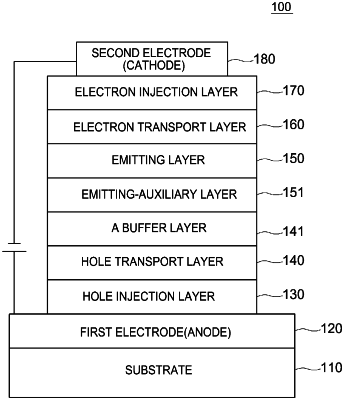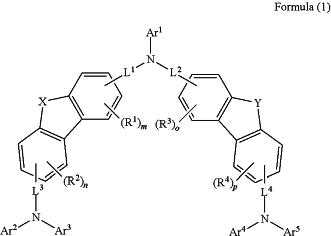| CPC H10K 85/636 (2023.02) [C07D 209/82 (2013.01); C07D 209/88 (2013.01); C07D 307/91 (2013.01); C07D 333/76 (2013.01); C07D 405/12 (2013.01); C07D 407/12 (2013.01); C07D 409/12 (2013.01); C07D 409/14 (2013.01); C09K 11/06 (2013.01); H05B 33/14 (2013.01); H10K 50/00 (2023.02); H10K 50/19 (2023.02); H10K 85/633 (2023.02); H10K 99/00 (2023.02); H10K 50/11 (2023.02); H10K 50/15 (2023.02); H10K 50/16 (2023.02); H10K 50/171 (2023.02); H10K 50/18 (2023.02); H10K 71/00 (2023.02); H10K 71/164 (2023.02); H10K 85/6572 (2023.02); H10K 85/6574 (2023.02); H10K 85/6576 (2023.02); H10K 2101/10 (2023.02); H10K 2101/30 (2023.02); H10K 2101/40 (2023.02); H10K 2102/351 (2023.02)] | 15 Claims |

|
1. A compound of Formula (1):
 wherein:
1) X or Y is NAr6, and the remaining X or Y is S or O,
2) Ar1, Ar2, Ar3, Ar4, Ar5, and Ar6 are each a C6-C60 aryl group, or a C2-C60 heterocyclic group including at least one hetero atom of O, N, S, Si or P,
3) R1, R2, R3, and R4 are each independently selected from the group consisting of deuterium; tritium; a halogen; a cyano group; a nitro group; a C6-C60 aryl group; a C2-C60 heterocyclic group including at least one hetero atom of O, N, S, Si or P; and a fused ring group of a C3-C60 aliphatic ring and a C6-C60 aromatic ring, or where a plurality of R1 to R4 are present, at least one pair of adjacent R1s, R2s, R3s, and R4s may independently combine to each other to form a ring, and the remaining R1 to R4 which do not form a ring are the same as defined above,
4) m, n, o and p are each independently an integer of 0 to 3, and where m, n, o or p is an integer of 2 or 3, R1 to R4 are the same or different from each other, and a plurality of R1, R2, R3 or R4 are the same or different from each other,
5) L1, L2, L3, and L4 are each independently selected from the group consisting of a single bond, a C6-C60 arylene group, and a C2-C60 divalent heterocyclic group containing at least one heteroatom selected from O, N, S, Si or P; a divalent fused ring group of a C3-C60 aliphatic ring and a C6-C60 aromatic ring; and a divalent aliphatic hydrocarbon group, and where they are not a single bond, each may be substituted with one or more substituents selected from the group consisting of deuterium; halogen; a C1-C20 alkylthio group; a C1-C20 alkoxyl group; a C1-C20 alkyl group; a C2-C20 alkenyl group; a C2-C20 alkynyl group; a C6-C20 aryl group; a C6-C20 aryl group substituted with deuterium; a C2-C20 heterocyclic group; a C3-C20 cycloalkyl group; and a C7-C20 arylalkyl group,
wherein the aryl group, heterocyclic group, fused ring group, alkyl group, alkenyl group, alkynyl group, alkoxy group, and aryloxy group in any of Ar1 to Ar6, R1 to R4, and L1 to L4 are each unsubstituted or substituted with one or more substituents selected from the group consisting of deuterium; halogen; a silane group substituted or unsubstituted with C1-C20 alkyl group or C6-C20 aryl group; a siloxane group; a boron group; a germanium group; a cyano group; a nitro group; a C1-C20 alkylthio group; a C1-C20 alkoxyl group; a C1-C20 alkyl group; a C2-C20 alkenyl group; a C2-C20 alkynyl group; a C6-C20 aryl group; a C6-C20 aryl group substituted with deuterium; a C2-C60 heterocyclic group including at least one hetero atom of O, N, S, Si or P; a C3-C20 cycloalkyl group; and a C8-C20 arylalkenyl group, with the proviso that Ar1 is not substituted with an amino group, and when these substituents are adjacent to each other, they may be bonded to each other to form a ring.
|